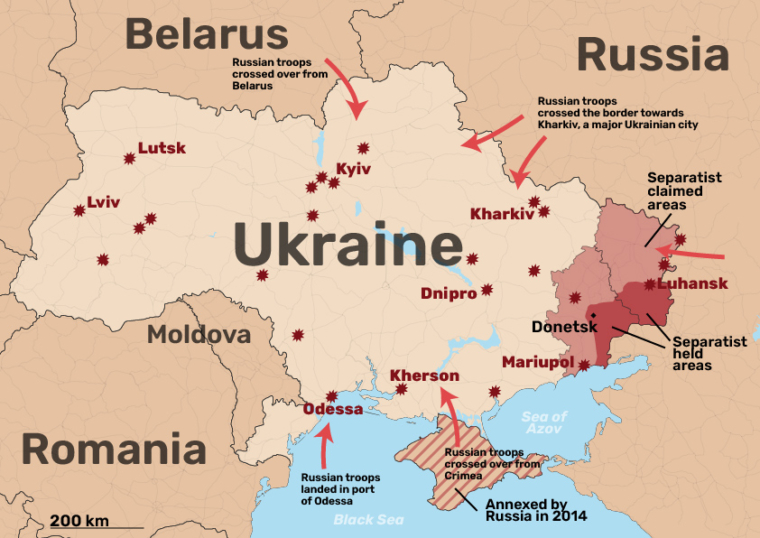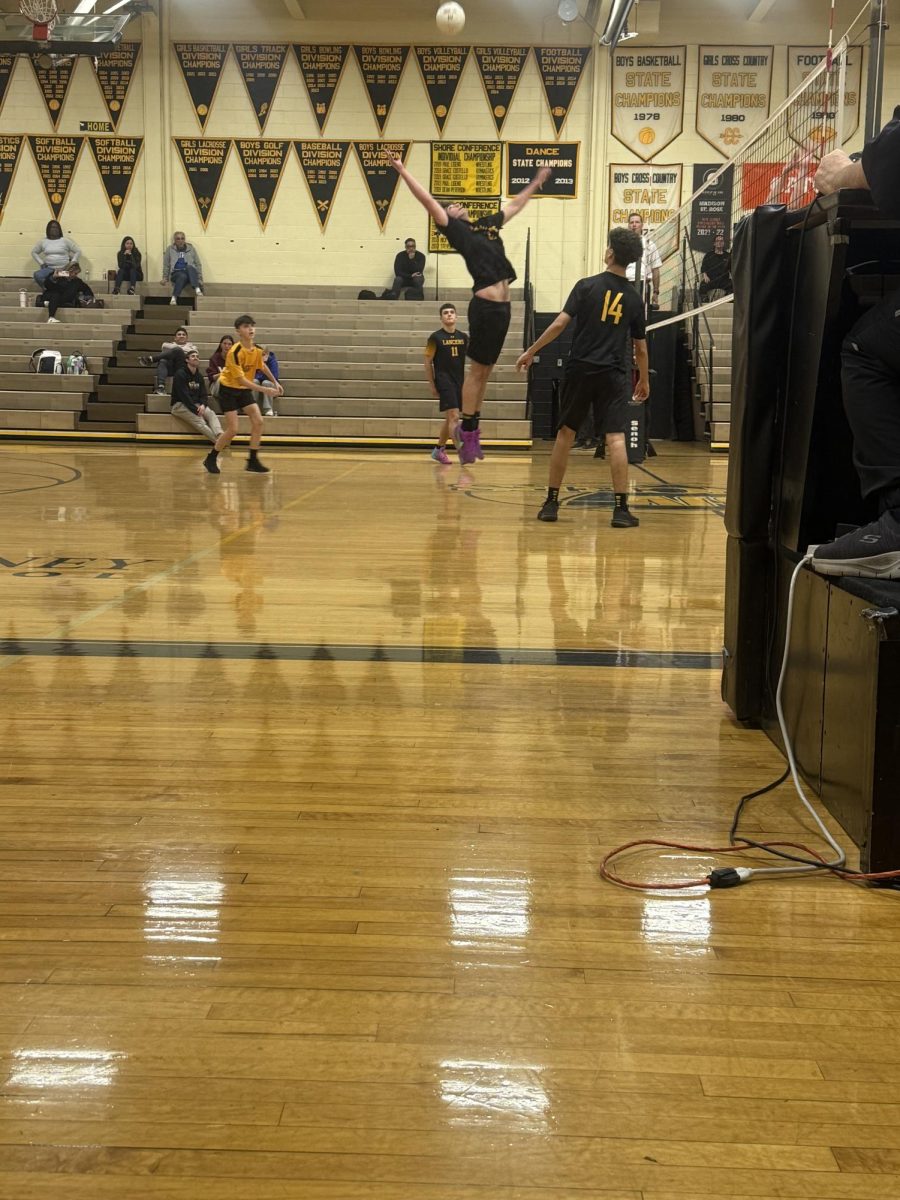Russia/Ukraine 101
March 4, 2022
Vladimir Putin, who has been president of Russia for the past 22 years, has decided to make drastic advancements in his ongoing takeover of Ukraine – a threat that has had Ukraine’s citizens on edge since 2014. When the Soviet Union crumbled in 1991, multiple Eastern European countries that were part of the former country joined NATO (the North Atlantic Treaty Organization, an intergovernmental military alliance that was founded in the wake of World War II). On June 12, 2020, Ukraine joined NATO’s enhanced opportunity partner interoperability program, signifying official partnership with the West.
Putin took the threat of NATO expansion into Eastern Europe personally, and has spent most of his presidency bolstering Russia’s military. In 2014, Ukraine pushed out President Viktor Yanukovych, who was close to Putin. This worsened the relationship between the two countries, and Putin believes that Ukraine is Russia’s to take. In the end, Putin wants to reclaim the power Russia held when the Soviet Union was still together.
According to The New York Times, “Mr. Putin appears intent on winding back the clock more than 30 years, establishing a broad, Russian-dominated security zone resembling the power Moscow wielded in Soviet days.”
On Thursday, Feb. 24, 2022, Russia invaded Ukraine. The long-feared outcome of Putin’s threats became a sudden reality when multiple bombings occurred in various major Ukrainian cities, including its capital, Kyiv. The bombings resulted in the deaths of 40 Ukrainian soldiers and many civilians. Along with the bombings, Russian soldiers also invaded from Belarus. The country lies on Ukraine’s northern border and was recently overtaken by Russia for reasons similar to their neighbor. These Russian soldiers have entered Chernobyl, a highly radioactive site in Northern Ukraine, which risks damage to the melted-down nuclear reactor – now encased in concrete – there. The Russian military also stormed Odessa (a Ukrainian port city) from Crimea, a peninsula connected to Ukraine that was annexed by Russia in 2014. The New York Times states the damage Russia had caused from this invasion attempt thus far: “Russian forces destroyed more than 70 military targets in Ukraine, including 11 airfields, three command points and a naval base, the Russian Defense Ministry said in a statement on Thursday.” Russia announced that it had disabled all of Ukraine’s air defenses and bases.
Even though the invasion may seem sudden to many, Russia has actually been amassing soldiers along Ukraine’s border for over a year. The U.S. and the European Union (EU) have begun taking minor economic measures against Russia through sanctions, including freezing multiple Russian banks and suspending a multi-billion dollar gas pipeline project to Germany. Germany and other EU countries have also provided weapons to Ukraine, but despite these measures, the likelihood of further outside military involvement is slim. The UN is set to vote Friday on what to do about the Russia-Ukraine situation, but Russia’s council member will likely veto any threats to Russia. The New York Times further states, “President Biden said on Twitter that he had met with his counterparts from other Group of 7 countries and that they had “agreed to move forward on devastating packages of sanctions and other economic measures to hold Russia to account.”
Below is a list of commonly asked questions about the conflict.
What does the U.S. have anything to do with this?
As a member of NATO, the U.S. is preparing to help Ukraine by sending military equipment. 8,500 American soldiers are on heightened alert, but they would be deployed to Poland or Romania, not Ukraine. The West does not want a war with Russia, but doesn’t want to leave Ukraine hanging, either. Although it is a tough line to walk, it is one many Western countries are willing to take if it means avoiding war.
If Russia wins, what happens?
If Russia wins, the U.S. and European leaders will be faced with rethinking European security and avoiding a larger war with Russia at the same time, which could be virtually impossible. We would also have to consider the possibility of a direct confrontation with Russia in the form of nuclear weapons.
Who is President Zelensky – what is he about?
Volodymyr Oleksandrovych Zelensky is the sixth president of Ukraine. Before his time in office, he was an actor and comedian, and his most famous role was actually as president of Ukraine in the show Servant of the People. After his role, he decided to run for president of Ukraine. Before his election he said, “People want to see a president like [Vasyl Holoborodko], with the same moral values.” He has gained much respect after refusing to leave his country and instead fighting with his soldiers.
How are the Russian soldiers being treated? What are they thinking?
Some Russian soldiers are actually abandoning or sabotaging their vehicles – thanks to low morale, lack of food, and fuel shortages, soldiers are surrendering in large numbers. Many of the soldiers are very young (around 19), not trained, and lightly armed. The soldiers have been found to deliberately punch holes in gas tanks to avoid fighting, and some are simply laying down their arms in surrender. A 40-mile convoy of Russian tanks stationed near Kyiv has come to a crawl, too.
How are Russian civilians viewing the war from home?
Many Russian civilians do not agree with Putin’s actions, especially since Ukraine and Russia have a close history and culture. Many people actually have family in both countries and do not want to see Ukraine fall. After the invasion on Thursday, thousands of Russian citizens swarmed city streets in protest. There were 1,702 arrests across over 50 Russian cities on Thursday as citizens chanted, “No to war!”
What kinds of punishments are other countries putting on Russia?
As an independent country and NATO partner, Ukraine has the full support of all NATO countries, including the United States and Britain. NATO countries are independently supporting Ukraine by sending weapons, ammunition, medical supplies, and more. The most surprising country to deliberately help Ukraine is Switzerland. Switzerland is famously known to be fiercely neutral but has broken 500 years of neutrality to freeze Russian assets.





